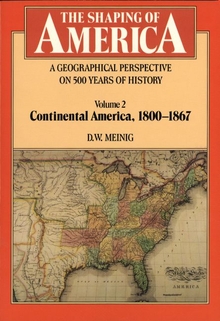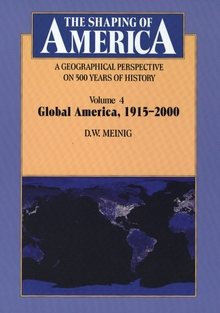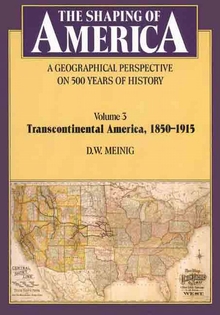The Shaping of America: A Geographical Perspective on 500 Years of History
WARNING
You are viewing an older version of the Yalebooks website. Please visit out new website with more updated information and a better user experience: https://www.yalebooks.com
Volume 2: Continental America, 1800–1867
D. W. Meinig
When Volume 1 of Donald Meinig's sweeping history of America was published, reviewers called it "a masterpiece in the best and old sense of the word" (Alfred W. Crosby, Southwestern Historical Quarterly), "a standard work in its field" (William Cronon, New York Times Book Review), and "one of the classic amalgamations of geography and history in the current literature" (Kenneth C. Martis, Journal of American History). In this new volume, the second in a projected four-volume series, D. W. Meinig again provides a fresh interpretation of the American past, bringing his special geographical perspective to the years between 1800 and 1867, the period when the nation experienced a dramatic expansion in territory, population, economy, and political tension that culminated in the Civil War. As in his first volume, Atlantic America, Meinig assesses the characteristics of regions and political territories and the relations among them, examining the dual roles played by geopolitics and ethnoculture in the shaping of the United States.
Meinig emphasizes the flux, uncertainty, and unpredictability of the expansion into continental America, showing how a multitude of individuals confronted complex and problematic issues. He discusses, for example, Jefferson's options regarding the Louisiana Purchase and the effects of his decisions on the Louisianians, and later controversies about U.S. pressures on Mexico and Cuba. He carefully traces the expansion of distinct regional societies and the social and geographical repositioning of various peoples (Indians, African-Americans, and subgroups of each). He describes and assesses the emerging patterns of cities, waterways, roads, railways, and attempts at national planning. And he presents the geopolitical alternatives considered in dealing with initial secessions, and the ragged tearing apart of the nation in 1861. Throughout, Meinig places the United States in its broader North American context, focusing on its relations with Canada, Mexico, and the West Indies.
Richly illustrated with maps, plans, and scenes, many of which were specially prepared for the book, Continental America is at once an invaluable complement to and a penetrating critique of more ordinary American histories.
"A monumental achievement. Meinig's book is a distinctive, highly personal, and brilliant interpretation of continental expansion."—Carville Earle, Louisiana State University
"A rich, dazzling, indispensable reinterpretation of an expanding America, with a panoramic view that embraces all of its regions and all of its peoples."—David Weber, author of The Spanish Frontier in North America
"Meinig has done it again. He manages to traverse terrain familiar to others and see it entirely freshly. Perhaps it's because he refuses to be trapped by the conventional ideas of any of the four or five academic disciplines which he has mastered in order to do his work. He has a mind impatient with the unconsidered, a style at once beguiling and convincing, and a seriousness of intention expressed cheerfully. This is a very good book."—Roger G. Kennedy, director of the National Museum of American History
"With one well-received volume already behind him, the brush strokes on this great canvas he has chosen to paint have only grown bolder and more confident. . . . Meinig has undertaken more than a geographer's task of interpreting history; he has recast the familiar time and place of historical events into a geographical framework that offers a truly new perspective on the present as well as the past."—John C. Hudson, Annals of Iowa
"A monumental, masterful synthesis which will surely come to be seen as one of the most distinguished achievements of North American historical geography—indeed, of North American geography and of historical geography internationally—in the twentieth century."—Alan R. H. Baker, Annals of the Association of American Geographers
"This book makes a significant contribution to our understanding of the making of America. . . . It has a coherence which multiple-authored works like the admirable collection of essays by R.D. Mitchell and P.A. Groves (1987) could not reasonably be expected to have."—Alan R.H. Baker, Annals of the Association of American Geographers
"In this magisterial and superbly readable book one of the premier historical geographers at work today examines the ways in which the United States marched to the Pacific despite opposition from Britain, Spain, Canada and hundreds of indigenous peoples. There are sections on the U.S. acquisition of Louisiana, Texas and Spanish Florida."—Books of the Southwest
"The project is remarkable for several characteristics in addition to its large scale. Meinig continually impresses with his ability to integrate narrative. Also impressive is the way in which he manages to occupy a middle ground within both political persuasions and intellectual traditions, achieving a remarkably even balance without for a moment seeming bland. His treatment of imperialism (a major theme) benefits particularly from this deftness, and he tackles issues involving Native peoples head on (one section is entitled 'Shoving the Indians Out of the Way') but avoids polemic."—Canadian Historical Review
"Meinig presents a disciplinary perspective combine with a masterful narrative of the principal issues and themes in America's transcontinental expansion."—Reginald C. Stuart, Canadian Journal of History
"An engaging, visual interpretation of the historical geography of North America in a period of continental realization. . . . A joy to read and savour. Meinig has mastered the art of weaving rich detail through a work of enormous scope. . . . Continental America is another superb achievement in an emerging series which promises to revise and revitalize our perspectives on the history of the United States."—Victor Konrad, Canadian Review of American Studies
"A very readable interpretation of American history. . . . A grandly conceived and executed work."—Choice
"Fascinating reading. . . . A most impressive piece of work showing great depth of scholarship. . . . Meinig has continued his impressive writing and research in this work and given those interested in the historical geography of America a most valuable two volumes both to read and to keep as a source of future reading and thought."—John F. Davis, Geographical Journal
"Continental America, 1800-1867, unravels the complex tapestry of events that expanded and organized the contents of American space. The topic is geographical development of nation and nationalism in a broad and thoughtful perspective. Meinig writes of the passions, perceptions, and ideologies that shaped the events that geographies. . . . The prodigious breadth and remarkable depth of analysis and understanding, exactly what scholars would expect from this preeminent interpreter of the American geographical past, demand acknowledgment. The prose is, as always, thoughtful and engaging, and cogent arguments stand well."—Joseph S. Wood, Geographical Review
"Perhaps the magnum opus of a distinguished career. . . . D.W. Meinig has given us a comprehensive and panoramic geographic reassessment of 'America's' dramatic history. Rich in subject and texture, Continental America will become a modern classic."—John C. Kendall, History
"[A] wonderful synthesis and thorough analysis. . . . Expands Meinig's already secure reputation and, by association, enhances that of historical geography."—Gregory S. Rose, Indiana Magazine of History
"The Shaping of America series is evolving into a modern-day classic in American historical geography. . . . Volumes 1 and 2 are musts for those interested in American historical geography and for historians seeking to expand their geographic understanding and perspective of large-scale historical trends. . . . The reader is in for a wonderful trip. . . . These volumes are certainly worth an examination for all those looking for a geopolitical perspective of American history."—Kenneth C. Martis, Journal of American History
"The Shaping of America will stand for generations as a research and publishing milestone. Its scope is simply breathtaking. . . . There can be no doubt about the superb and sustained scholarship exhibited by The Shaping of America. It is a truly astonishing achievement. . . . Meinig's project is simply stunning in its ambition as well as outstanding in its achievement. Its scope and its completion mark it as one of the most remarkable products of North American geography during the twentieth century."—Alan R.H.Baker, Journal of Historical Geography
"Continental America, 1800-1867 is an impressive volume, breath-taking in its scope, and exciting and challenging in the variety of its insights and new perspectives."—Allan D. Bogue, Journal of Historical Geography
"One of modern geography's most substantial achievements. . . . The project, taken as a whole and at face value, evokes the same sort of awe as (and many of the superlatives used to describe) the Grand Canyon. . . . The resulting volumes are notable feats of condensation, integration and interpretation. Each rests upon prodigious reading and the intelligent assimilation of arguments new and old advanced by scholars from a number of disciplines. In every volume, indeed it is no exaggeration to say on every page of every volume, Meinig writes with skill and care. . . . There can be no doubt that it is a remarkable achievement, one of the great accomplishments of twentieth century American geography. Meinig can only be admired for the scope of this ambitious project and the consummate skill and dogged resolve with which he brought it to fruition. He has painted a coherent and often compelling picture on a canvas far larger than most geographers have thought to address and which hardly any seem likely to engage in the future."—Graeme Wynn, Journal of Historical Geography
"Anyone who has taught the 'frontier course' knows how utterly central geography is to the story. Anyone seriously interested in the West, both its times and spaces, will value this book."—Walter Nugent, Montana, The Magazine of Western History
"A refreshing and novel perspective on our country."—Edward Tenner, New York Newsday
"Meinig has succeeded in providing us with a breathtakingly original, imaginative and idiosyncratic reinterpretation of American geography and history. . . . Richly illustrated . . . to amplify and illuminate the narrative. . . . Anyone who cares about the road this nation traveled to reach its present size and shape, the problems encountered along the way and how they were resolved will be stimulated and enriched by reading this imposing and impressive book."—Robert V. Remini, Newsday
"Very well-referenced and well-illustrated. . . . An extremely valuable text for courses in history and geography that deal with North America. Historians and geographers, especially those who teach, will especially appreciate the outstanding selection of maps and contemporaneous illustrations. The cartography throughout this book is absolutely breathtaking. . . . The next book in the series is being anticipated with much excitement, for it is sure to be another major contribution to the literature on the historical geography of North America."—Douglas C. Munski, North Dakota History: Journal of the Northern Plains
"The Shaping of America is well on its way to being a masterpiece."—Alfred W. Crosby, Southwestern Historical Quarterly
"A work of breathtaking scope. . . . Continental America offers a panoramic historical synthesis in the best tradition of Braudel."—David Brown, Times Higher Education Supplement
"This second volume of Meinig's planned four-volume series on five hundred years of American development is a masterful interpretation of the trials and triumphs of an emerging nation. Meinig addresses a myriad of interrelated issues such as territorial expansion, conflicts with Indians, agriculture, urbanization, the Industrial Revolution, and the Civil War. His fresh approach and engaging prose carries the reader through this lengthy, but rarely overwhelming text."—Margaret M. Gripshover, West Virginia History
"A bold and brave synthesis. Meinig changes the way one thinks about important questions, making it impossible to see once-familiar events in quite the same way. In arguing so forcefully for the importance of geographical context in interpretations of American history, Continental America should encourage all historians to pay closer attention to the roles of space and place in their narratives."—Nancy Langston, William and Mary Quarterly
Publication Date: February 22, 1995
86 b/w illus.










